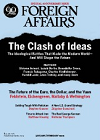According to a growing chorus of pundits and economists, China — already the world’s most prolific exporter, largest sovereign creditor, and second-largest economy — will someday soon provide the world’s reserve currency. According to this view, just as the dollar dethroned the British pound in the interwar years, so the yuan will soon displace the dollar, striking a blow to U.S. interests. As the economist Arvind Subramanian recently wrote, the yuan “could become the premier reserve currency by the end of this decade, or early next decade.”
This view has gained traction as Chinese leaders have launched a concerted effort to internationalize the yuan. During the G-20 summit in November 2008, at the height of the financial crisis, Chinese president Hu Jintao called for “a new international financial order that is fair, just, inclusive, and orderly.” Beijing soon began to encourage the use of its currency in international trade, swap arrangements between central banks, and bank deposits and bond issuances in Hong Kong. During the first six months of 2011, trade transactions settled in yuan totaled around $146 billion, a 13-fold increase over the same period during the previous year. By mid-2011, yuan deposits in Hong Kong equaled $85 billion, a roughly tenfold jump since Hu’s 2008 statement. The yuan is already accepted as a form of payment in Mongolia, Pakistan, Thailand, and Vietnam. Chinese authorities have indicated that as soon as 2015, they want the yuan to be included in the basket of major currencies that determines the value of Special Drawing Rights (SDRs), the reserve asset issued by the International Monetary Fund. And Beijing has announced its intention to transform Shanghai into an international financial center by 2020.
This article was originally published by Foreign Affairs. You can read the rest of the article here.
You can read exclusive content from Gateway House: Indian Council on Global Relations, here.
Copyright © 2011 by the Council on Foreign Relations, Inc.


